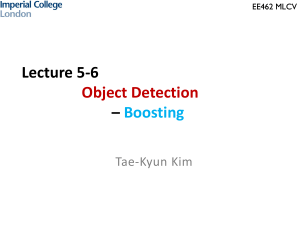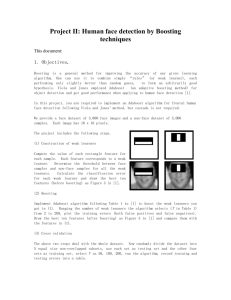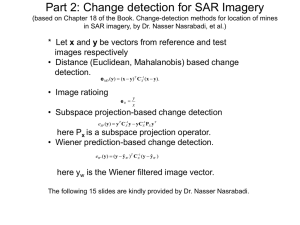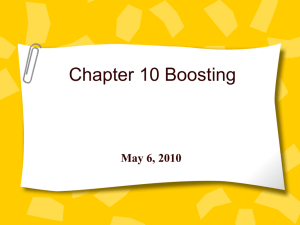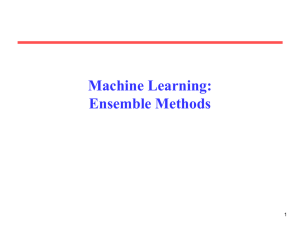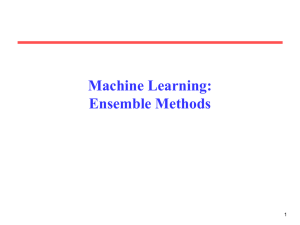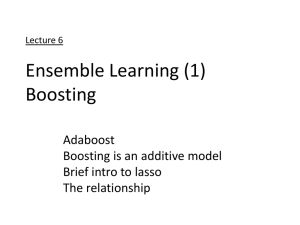EE462 MLCV
advertisement
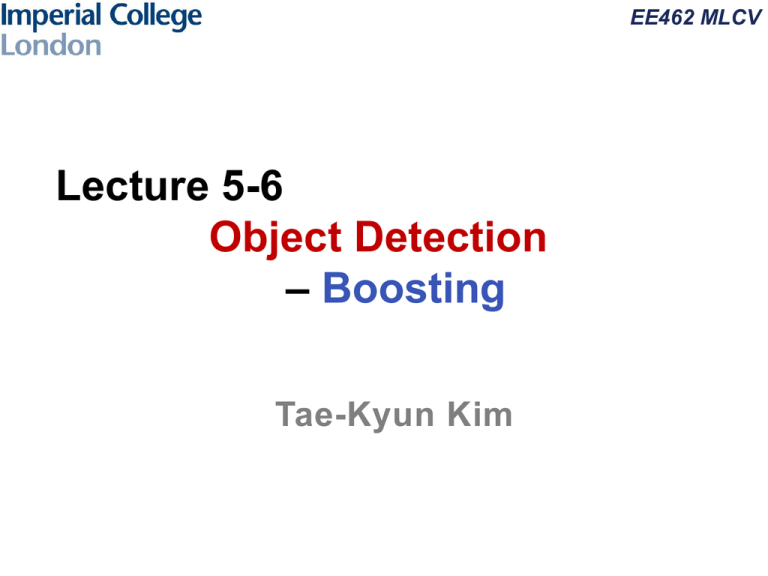
EE462 MLCV
Lecture 5-6
Object Detection
– Boosting
Tae-Kyun Kim
EE462 MLCV
Face Detection Demo
2
Multiclass object detection
EE462 MLCV
[Torralba et al PAMI 07]
A boosting algorithm, originally for binary class problems, has been
extended to multi-class problems.
3
EE462 MLCV
Object Detection
Input: A single image is given as input, without any prior knowledge.
4
Object Detection
EE462 MLCV
Output is a set of tight bounding boxes (positions and scales) of
instances of a target object class (e.g. pedestrian).
5
Object Detection
EE462 MLCV
Scanning windows: We scan every scale and every pixel location in
an image.
6
EE462 MLCV
Number of Hypotheses
It ends up with a huge number of candidate windows .
x
# of scales
# of pixels
Number of Windows: e.g. 747,666
7
Time per window
EE462 MLCV
What amount of time is given to process a single scanning window?
SIFT
……
dimension D
or raw pixels
…
Num of feature vectors:
747,666
Classification:
8
EE462 MLCV
Time per window
……
dimension D
or raw pixels
…
Num of feature vectors:
747,666
In order to finish the task say in 1 sec
Time per window (or vector):
0.00000134 sec
Neural Network?
Nonlinear SVM?
9
EE462 MLCV
Examples of face detection
From Viola, Jones, 2001
10
EE462 MLCV
More traditionally…
The search space is narrowed down.
By Integrating Visual Cues [Darrell et al IJCV 00].
Face pattern detection output (left).
Connected components recovered from stereo range
data (mid).
Regions from skin colour (hue) classification (right).
11
EE462 MLCV
Since about 2001 (Viola &Jones 01)…
“Boosting Simple Features” has been a
dominating art.
Adaboost classification
Strong classifier
Weak classifier
Weak classifiers: Haar-basis features/functions
The feature pool size is e.g. 45,396 (>>T)
12
EE462 MLCV
Introduction to Boosting Classifiers
- AdaBoost (Adaptive Boosting)
EE462 MLCV
Boosting
• Boosting gives good results even if the base
classifiers have a performance slightly better than
random guessing.
• Hence, the base classifiers are called
weakclassifiers or weaklearners.
14
EE462 MLCV
Boosting
For a two (binary)-class classification problem, we train with
training data x1,…, xN
target variables t1,…, tN, where tN ∈ {-1,1},
data weight w1,…, wN
weak (base) classifier candidates y(x) ∈ {-1, 1}.
15
EE462 MLCV
Boosting does
Iteratively,
1) reweighting training samples,
by assigning higher weights to previously misclassified samples,
2) finding the best weakclassifier for the weighted samples.
50
21 rounds
3
4
5
round
rounds
16
EE462 MLCV
In the previous example, the weaklearner was defined
by a horizontal or vertical line, and its direction.
-1
+1
17
EE462 MLCV
AdaBoost (adaptive boosting)
1. Initialise the data weights {wn} by wn(1) = 1/N for n = 1,… ,N.
2. For m = 1, … ,M
: the number of weak classifiers to choose
(a) Learn a classifier ym(x) that minimises the weighted error, among all
weak classifier candidates
where I is the impulse function.
(b) Evaluate
18
EE462 MLCV
and set
(c) Update the data weights
3. Make predictions using the final model by
19
EE462 MLCV
Boosting
20
EE462 MLCV
Boosting as an optimisation
framework
21
EE462 MLCV
Minimising Exponential Error
• AdaBoost is the sequential minimisation of the exponential error function
where tn ∈ {-1, 1} and fm(x) is a classifier as a linear combination of
base classifiers yl(x)
• We minimise E with respect to the weight αl and the parameters of
the base classifiers yl(x).
22
EE462 MLCV
• Sequential Minimisation: suppose that the base classifiers y1(x) ,. …,
ym-1(x) and their coefficients α1, …, αm-1 are fixed, and we minimise only
w.r.t. am and ym(x).
• The error function is rewritten by
where wn(m) = exp{−tn fm-1 (xn)} are constants.
23
EE462 MLCV
• Denote the set of data points correctly classified by ym(xn) by Tm, and
those misclassified Mm , then
• When we minimise w.r.t. ym(xn), the second term is constant and
minimising E is equivalent to
24
EE462 MLCV
• By setting the derivative w.r.t. αm to 0, we obtain
where
• From
As
The term exp(-αm/2) is independent of n, thus we obtain
25
EE462 MLCV
Exponential Error Function
• Pros: it leads to simple derivations of Adaboost algorithms.
• Cons: it penalises large negative values. It is prone to outliers.
The exponential (green)
rescaled cross-entropy (red)
hinge (blue), and
misclassification (black)
error ftns.
26
EE462 MLCV
Existence of weaklearners
Definition of a baseline learner
Data weights:
Set
Baseline classifier:
Error is at most ½.
for all x
Each weaklearner in Boosting is required s.t.
Error of the composite hypothesis goes to zero as
boosting rounds increase [Duffy et al 00].
27
EE462 MLCV
Robust real-time object detector
Viola and Jones, CVPR 01
http://www.iis.ee.ic.ac.uk/icvl/mlcv/viola_cvpr01.pdf
EE462 MLCV
Boosting Simple Features
[Viola and Jones CVPR 01]
Adaboost classification
Strong
classifier
Weak
classifier
Weak classifiers: Haar-basis like functions (45,396 in total
feature pool)
……
24
pixels
24 pixels
29
EE462 MLCV
Learning (concept illustration)
Resized to
24x24
Resized to
24x24
Face
images
Nonface
images
Output:
weaklearners
30
Evaluation (testing)
EE462 MLCV
The learnt boosting classifier i.e.
is applied to every scanwindow.
The response map is obtained, then non-local maxima suppression is performed.
Non-local
maxima
suppression
31
EE462 MLCV
Receiver Operating Characteristic (ROC)
Boosting classifier score (prior to the binary classification) is compared with a
threshold.
> Threshold
Class 1 (face)
< Threshold
Class -1 (no face)
The ROC curve is drawn by the false negative rate against the false positive
rate at various threshold values:
False positive rate (FPR) = FP/N
False negative rate (FNR) = FN/P
where P positive instances,
N negative instances,
FP false positive cases, and
FN false negative cases.
1
FNR
0
FPR
1
32
EE462 MLCV
How to accelerate the boosting
training and evaluation
EE462 MLCV
Integral Image
A value at (x,y) is the sum of the pixel values
above and to the left of (x,y).
The integral image can be computed in one
pass over the original image.
34
EE462 MLCV
Boosting Simple Features
[Viola and Jones CVPR 01]
Integral image
The sum of original image values
within the rectangle can be
computed: Sum = A-B-C+D
This provides the fast evaluation of
Haar-basis like features
1
3
5
2
4
6
(6-4-5+3)-(4-2-3+1)
35
EE462 MLCV
Evaluation (testing)
x
y
ii(x,y)
*In the coursework2, you can first crop image windows, then
compute the integral images of the windows, than of the entire
image.
36
EE462 MLCV
Boosting as a Tree-structured
Classifier
EE462 MLCV
Boosting (very shallow network)
The strong classifier H as boosted decision stumps has
a flat structure
x
……
c0 c1
c0 c1
……
c0 c1
c0 c1
c0 c1
c0 c1
Cf. Decision “ferns” has been shown to outperform “trees” [Zisserman et al,
07] [Fua et al, 07]
38
EE462 MLCV
Boosting -continued
Good generalisation is achieved by a flat structure.
It provides fast evaluation.
It does sequential optimisation.
A strong boosting classifier
A strong boosting classifier
Boosting Cascade [viola & Jones 04],
Boosting chain [Xiao et al]
It is very imbalanced tree
structured.
It speeds up evaluation by
rejecting easy negative
samples at early stages.
It is hard to design
T=2
5
10
20
50
100
……
39
EE462 MLCV
A cascade of classifiers
The detection system requires good detection rate and
extremely low false positive rates.
False positive rate and detection rate are
fi is the false positive rate of i-th classifier on the
examples that get through to it.
The expected number of features evaluated is
pj is the proportion of windows input to i-th classifier.
40
EE462 MLCV
Demo video: Fast
evaluation
41
EE462 MLCV
Object Detection
by a Cascade of Classifiers
It speeds up object detection by coarse-to-fine search.
Romdhani et al. ICCV01
42
